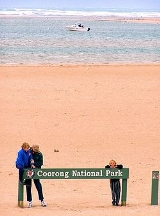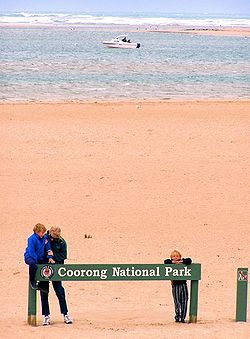
Murray Mouth
Encyclopedia

Southern Ocean
The Southern Ocean comprises the southernmost waters of the World Ocean, generally taken to be south of 60°S latitude and encircling Antarctica. It is usually regarded as the fourth-largest of the five principal oceanic divisions...
. The Murray Mouth's location is changeable. Historical records show that the channel out to sea moves along the sand dunes over time. At times of greater river flow and rough seas, the two bodies of water would erode the sand dunes to create a new channel leaving the old one to silt and disappear.
The mouth is between two sandhill peninsulas. Sir Richard Peninsula on the northwest separates the Goolwa
Goolwa, South Australia
Goolwa is a historic river port on the Murray River near the Murray Mouth in South Australia, and joined by a bridge to Hindmarsh Island. The name "Goolwa" means "elbow" in Ngarrindjeri, the local Aboriginal language....
channel (the main river channel) from the ocean. The much longer Younghusband Peninsula
Younghusband Peninsula
Younghusband Peninsula is a long narrow peninsula in South Australia, at . It separates Encounter Bay which is part of the Southern Ocean from the Coorong which is part of the estuary of the River Murray. It lies entirely within the Coorong National Park. The peninsula is over 110 kilometres long,...
separates the Coorong from the ocean on the southeast of the mouth.
The Murray Mouth is separated from Lake Alexandrina by a row of low islands. The largest one, directly facing the mouth, is Hindmarsh Island
Hindmarsh Island
Hindmarsh Island is an island in the lower Murray River near the town of Goolwa, South Australia. Located on the Fleurieu Peninsula, it is a popular tourist destination, which has increased in popularity since the Hindmarsh Island bridge was opened in 2001...
. A series of barrage
Barrage
Barrage may refer to:In music* Barrage , a Canadian violin ensemble, or* Barrage , their self-titled debut albumIn engineering...
s join the islands, separating the salt water from the fresh water of the lakes and river. The barrages can be opened during high river flow.
Ancient History
The original course of the Murray River was to a mouth near Port Pirie where a large delta is still visible protruding into the calm waters of Spencer Gulf. An uplift of the land blocked the river near the southern end of the Flinders Ranges, and the river eventually found its way to a new mouth near Lake Alexandrina.Water flow

Irrigation
Irrigation may be defined as the science of artificial application of water to the land or soil. It is used to assist in the growing of agricultural crops, maintenance of landscapes, and revegetation of disturbed soils in dry areas and during periods of inadequate rainfall...
in four of Australia's states, as well as supplying water to most towns along the river, and many further away through various pipeline
Pipeline transport
Pipeline transport is the transportation of goods through a pipe. Most commonly, liquids and gases are sent, but pneumatic tubes that transport solid capsules using compressed air are also used....
s. It has been widely accepted that too much water is being extracted; however business and political concerns make it difficult to remedy the problem. A visible symptom of the over-extraction of river water is the closing of the Murray Mouth.
Since October 2002, two dredging machines have operated at the Murray Mouth, moving sand from the channel to maintain a minimal flow from the sea and into the Coorong's lagoon system. Without the 24-hour dredging, the mouth would silt up and close, cutting the supply of fresh seawater into the Coorong, which would then warm up, stagnate
Water stagnation
Water stagnation occurs when water stops flowing. Stagnant water can be a major environmental hazard.-Dangers:Malaria and dengue are among the main dangers of stagnant water, which can become a breeding ground for the mosquitoes that transmit these diseases.Stagnant or Stailment water can be...
and die.
In mid-2006 the dredging was scaled back as a result of the improved conditions at the mouth. Now only one dredging machine operates, and permission was granted to one commercial operator to navigate the channel between Goolwa and the Coorong, passing the mouth.
External links
- South Coast Story, John C Tolley, Rowett Print, Mt Compass SA, 1968 ISBN 0-9587964-3-2

